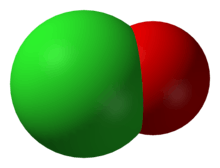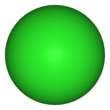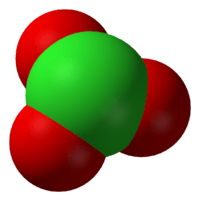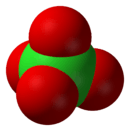Hypochlorite
 | |
| Names | |
|---|---|
| IUPAC name
Hypochlorite | |
| Systematic IUPAC name
chlorate(I) | |
| Identifiers | |
3D model (JSmol) |
|
| ChEBI | |
| ChemSpider | |
| ECHA InfoCard | 100.235.795 |
| 682 | |
PubChem CID |
|
| UN number | 3212 |
| |
| |
| Properties | |
| Conjugate acid | Hypochlorous acid |
Except where otherwise noted, data are given for materials in their standard state (at 25 °C [77 °F], 100 kPa). | |
| Infobox references | |
In chemistry, hypochlorite is an ion with the chemical formula ClO−. It forms derivatives with a number of cations to form hypochlorites, which may also be regarded as the salts of hypochlorous acid. Common examples include sodium hypochlorite (household bleach) and calcium hypochlorite (a component of bleaching powder, swimming pool "chlorine").[1]
The name can also refer to esters of the hypothetical hypochlorous acid, namely organic compounds with a ClO– group covalently bound to the rest of the molecule. Examples include methyl hypochlorite and t-butyl hypochlorite.[2]
Most hypochlorite salts are unstable in their pure forms, and are normally handled as aqueous solutions. Their primary applications are as bleaching, disinfection, and water treatment agents but they are also used in chemistry for chlorination and oxidation reactions.
Chemistry
Acid reaction
Acidification of hypochlorites generates hypochlorous acid. This exists in an equilibrium with chlorine gas, which can bubble out of solution. The equilibrium is subject to Le Chatelier's principle; thus a high pH drives the reaction to the left by consuming H+
ions, promoting the disproportionation of chlorine into chloride and hypochlorite, whereas a low pH drives the reaction to the right, promoting the release of chlorine gas.
- 2 H+
+ ClO−
+ Cl−
⇌ Cl
2 + H
2O
Hypochlorous acid also exists in equilibrium with its anhydride; dichlorine monoxide.[3]
- 2 HOCl ⇌ Cl2O + H2O K (at 0 °C) = 3.55×10−3 dm3 mol−1
Stability
Hypochlorites are generally unstable and many compounds exist only in solution. Only lithium hypochlorite LiOCl, calcium hypochlorite Ca(OCl)2 and barium hypochlorite Ba(ClO)2 have been isolated as pure anhydrous compounds, all of which are solids. A few more can be produced as aqueous solutions. In general the greater the dilution the greater their stability.
The hypochlorite ion is unstable with respect to disproportionation. Upon heating, it degrades to a mixture of chloride, oxygen and other chlorates:
- 2 ClO−
→ 2 Cl−
+ O
2
- 3 ClO−
→ 2 Cl−
+ ClO−
3
This reaction is exothermic and in the case of concentrated hypochlorites, such as LiOCl and Ca(OCl)2, can lead to a dangerous thermal runaway and potentially explosions.[4][5]
The alkali metal hypochlorites decrease in stability down the group. Anhydrous lithium hypochlorite is stable at room temperature; however, sodium hypochlorite has not be prepared drier than the pentahydrate (NaOCl·(H2O)5). This is unstable above 0 °C;[6] although the more dilute solutions encountered as household bleach possesses better stability. Potassium hypochlorite (KOCl) is known only in solution.[7]
It is not possible to determine trends for the alkaline earth metal salts, as many of them cannot be formed. Beryllium hypochlorite is unheard of; however, this is not unexpected as the Be2+ ion is not known in solution. Pure magnesium hypochlorite cannot be prepared; however, solid Mg(OH)OCl is known.[7] Calcium hypochlorite is produced on an industrial scale and has good stability. Strontium hypochlorite, Sr(OCl)2, is not well characterised and its stability has not yet been determined.[8]
Hypochlorites do not form stable coordination complexes with heavy metals and so are not viable ligands. Transition metal hypochlorites are generally unheard of, although hypochlorite will briefly coordinate to a Mn(III)-salen complex during the Jacobsen epoxidation reaction. The resulting compound is unstable and rapidly decomposes to give the Mn(V) complex.
Lanthanide hypochlorites are also unstable; however, they have been reported as being more stable in their anhydrous forms than in the presence of water.[9] Hypochlorite has been used to oxidise cerium from its +3 to +4 oxidation state.[10]
Hypochlorous acid itself is not stable in isolation as it decomposes to form chlorine.
Covalent hypochlorites are typically very unstable.
Reactions with ammonia
Hypochlorites react with ammonia first giving chloramine (NH
2Cl), then dichloramine (NHCl
2) and finally nitrogen trichloride (NCl
3).
- NH
3 + ClO−
→ HO−
+ NH
2Cl
- NH
2Cl + ClO−
→ HO−
+ NHCl
2
- NHCl
2 + ClO−
→ HO−
+ NCl
3
The chloramines are very irritating to the eyes and lungs and are toxic above certain concentrations. They are a significant risk for use of liquid bleach for household cleaning.[11] Nitrogen trichloride is also a very sensitive explosive.
Preparation
Hypochlorite salts
Several hypochlorites can be formed by a disproportionation reaction between chlorine and metal hydroxides. The reaction is performed at close to room temperature, as further oxidation will occur at higher temperatures leading to the formation of chlorates. This process is widely used for the industrial production of sodium hypochlorite (NaClO) and calcium hypochlorite (Ca(ClO)2).
Large amounts of sodium hypochlorite are also produced electrochemically via an un-separated chloralkali process. In this process brine is electrolisyzed to form Cl
2 which dissociates in water to form hypochlorite. This reaction must be run in non-acidic conditions to prevent chlorine gas from bubbling out of solution:
- 2 Cl−
→ Cl
2 + 2 e−
- Cl
2 + H
2O ⇌ HClO + Cl−
+ H+
Small amounts of more unusual hypochlorites may also be formed by a salt metathesis reaction between calcium hypochlorite and various metal sulfates. This reaction is performed in water and relies on the formation of insoluble calcium sulfate, which will precipitate out of solution, driving the reaction to completion.
- Ca(ClO)2 + MSO4 → M(ClO)2 + CaSO4
Organic hypochlorites
Hypochlorite esters are in general formed from the corresponding alcohols, by treatment with any of a number of reagents (e.g. chlorine, hypochlorous acid, dichlorine monoxide and various acidified hypochlorite salts).[2]
Biochemistry
Role in fighting infections
In response to infection, the human immune system generates minute quantities of hypochlorite. This takes place within special white blood cells, called neutrophil granulocytes, which engulf viruses and bacteria in an intracellular vacuole called the phagosome, where they are digested.
Part of the digestion mechanism involves an enzyme-mediated respiratory burst, which produces reactive oxygen-derived compounds, including superoxide (which is produced by NADPH oxidase). Superoxide decays to oxygen and hydrogen peroxide, which is used in a myeloperoxidase-catalysed reaction to convert chloride to hypochlorite.[12][13][14]
Low concentrations of hypochlorite were also found to interact with a microbe's heat shock proteins, stimulating their role as intra-cellular chaperone and causing the bacteria to form into clumps (much like an egg that has been boiled) that will eventually die off.[15] The same study found that low (micromolar) hypochlorite levels induce E. coli and Vibrio cholerae to activate a protective mechanism, although its implications were not clear.[15]
In some cases, the base acidity of hypochlorite compromises a bacterium's lipid membrane, a reaction similar to popping a balloon.
Industrial and domestic uses
Hypochlorites, especially of sodium ("liquid bleach", "Javel water") and calcium ("bleaching powder") are widely used, industrially and domestically, to whiten clothes, lighten hair color and remove stains. They were the first commercial bleaching products, developed soon after that property was discovered in 1785 by French chemist Claude Berthollet.
Hypochlorites are also widely used as broad spectrum disinfectants and deodorizers. That application started soon after French chemist Labarraque discovered those properties, around 1820 (still before Pasteur formulated his germ theory of disease).
Laboratory uses
As oxidizing agents
Hypochlorite is the strongest oxidizing agent of the chlorine oxyanions. This can be seen by comparing the standard half cell potentials across the series; the data also shows that the chlorine oxyanions are stronger oxidizers in acidic conditions.[16]
| Ion | Acidic reaction | E° (V) | Neutral/basic reaction | E° (V) |
|---|---|---|---|---|
| Hypochlorite | H+ + HOCl + e− → 1⁄2 Cl2(g) + H2O | 1.63 | ClO− + H2O + 2 e− → Cl− + 2OH− | 0.89 |
| Chlorite | 3 H+ + HOClO + 3 e− → 1⁄2 Cl2(g) + 2 H2O | 1.64 | ClO− 2 + 2 H2O + 4 e− → Cl− + 4 OH− | 0.78 |
| Chlorate | 6 H+ + ClO− 3 + 5 e− → 1⁄2 Cl2(g) + 3 H2O | 1.47 | ClO− 3 + 3 H2O + 6 e− → Cl− + 6 OH− | 0.63 |
| Perchlorate | 8 H+ + ClO− 4 + 7 e− → 1⁄2 Cl2(g) + 4 H2O | 1.42 | ClO− 4 + 4 H2O + 8 e− → Cl− + 8 OH− | 0.56 |
Hypochlorite is a sufficiently strong oxidiser to convert Mn(III) to Mn(V) during the Jacobsen epoxidation reaction and to convert Ce3+
to Ce4+
.[10]
This oxidising power is what makes them effective bleaching agents and disinfectants.
In organic chemistry, hypochlorites can be used to oxidise primary alcohols to carboxylic acids.[17]
As chlorinating agents
Hypochlorite salts can also act as chlorinating agents. For example, they can chlorinate the benzene ring of phenols and other electron rich aromatic hydrocarbons.
Related oxyanions
Chlorine can be the nucleus of oxoanions with oxidation states of −1, +1, +3, +5, or +7. (The element can also assume oxidation state of +4 is seen in the neutral compound chlorine dioxide ClO2).
| Chlorine oxidation state | −1 | +1 | +3 | +5 | +7 |
|---|---|---|---|---|---|
| Name | chloride | hypochlorite | chlorite | chlorate | perchlorate |
| Formula | Cl− | ClO− | ClO− 2 |
ClO− 3 |
ClO− 4 |
| Structure |  |
 |
 |
See also
References
- ↑ Greenwood, Norman N.; Earnshaw, Alan (1997). Chemistry of the Elements (2nd ed.). Butterworth-Heinemann. ISBN 0-08-037941-9.
- 1 2 Mintz, M. J.; C. Walling (1969). "t-Butyl hypochlorite". Organic Syntheses. 49: 9. doi:10.15227/orgsyn.049.0009.
- ↑ Inorganic chemistry, Egon Wiberg, Nils Wiberg, Arnold Frederick Holleman, "Hypochlorous acid", p. 442, section 4.3.1
- ↑ Ropp, Richard C. Encyclopedia of the alkaline earth compounds. Oxford: Elsevier Science. p. 75. ISBN 0444595538.
- ↑ Clancey, V.J. (1975). "Fire hazards of calcium hypochlorite". Journal of Hazardous Materials. 1 (1): 83–94. doi:10.1016/0304-3894(75)85015-1.
- ↑ Brauer, G. (1963). Handbook of Preparative Inorganic Chemistry; Vol. 1 (2nd ed.). Academic Press. p. 309.
- 1 2 Aylett, founded by A.F. Holleman ; continued by Egon Wiberg ; translated by Mary Eagleson, William Brewer ; revised by Bernhard J. (2001). Inorganic chemistry (1st English ed., [edited] by Nils Wiberg. ed.). San Diego, Calif. : Berlin: Academic Press, W. de Gruyter. p. 444. ISBN 0123526515.
- ↑ Ropp, Richard (2012). Encyclopedia of the Alkaline Earth Compounds. Newnes. p. 76. ISBN 0444595538.
- ↑ Vickery, R. C. (1 April 1950). "Some reactions of cerium and other rare earths with chlorine and hypochlorite". Journal of the Society of Chemical Industry. 69 (4): 122–125. doi:10.1002/jctb.5000690411.
- 1 2 V. R. Sastri [et. al.] (2003). Modern Aspects of Rare Earths and their Complexes (1st ed.). Burlington: Elsevier. p. 38. ISBN 0080536689.
- ↑ Mustafa Odabasi (2008): "Halogenated Volatile Organic Compounds from the Use of Chlorine-Bleach-Containing Household Products". Environmental Science & Technology, volume 42, issue 5, pages 1445–1451. doi:10.1021/es702355u
- ↑ Harrison, J. E.; J. Schultz (1976). "Studies on the chlorinating activity of myeloperoxidase". Journal of Biological Chemistry. 251 (5): 1371–1374. PMID 176150.
- ↑ Thomas, E. L. (1979). "Myeloperoxidase, hydrogen peroxide, chloride antimicrobial system: Nitrogen-chlorine derivatives of bacterial components in bactericidal action against Escherichia coli". Infect. Immun. 23 (2): 522–531. PMC 414195. PMID 217834.
- ↑ Albrich, JM; McCarthy, CA; Hurst, JK (January 1981). "Biological reactivity of hypochlorous acid: implications for microbicidal mechanisms of leukocyte myeloperoxidase". Proceedings of the National Academy of Sciences of the United States of America. 78 (1): 210–4. Bibcode:1981PNAS...78..210A. doi:10.1073/pnas.78.1.210. PMC 319021. PMID 6264434.
- 1 2 Jakob, U.; J. Winter; M. Ilbert; P.C.F. Graf; D. Özcelik (14 November 2008). "Bleach Activates A Redox-Regulated Chaperone by Oxidative Protein Unfolding". Cell. Elsevier. 135 (4): 691–701. doi:10.1016/j.cell.2008.09.024. PMC 2606091. PMID 19013278. Retrieved 2008-11-19.
- ↑ Cotton, F. Albert; Wilkinson, Geoffrey (1988), Advanced Inorganic Chemistry (5th ed.), New York: Wiley-Interscience, p. 564, ISBN 0-471-84997-9
- ↑ Warren, Jonathan Clayden, Nick Greeves, Stuart. Organic chemistry (2nd ed.). Oxford: Oxford University Press. p. 195. ISBN 978-0-19-927029-3.